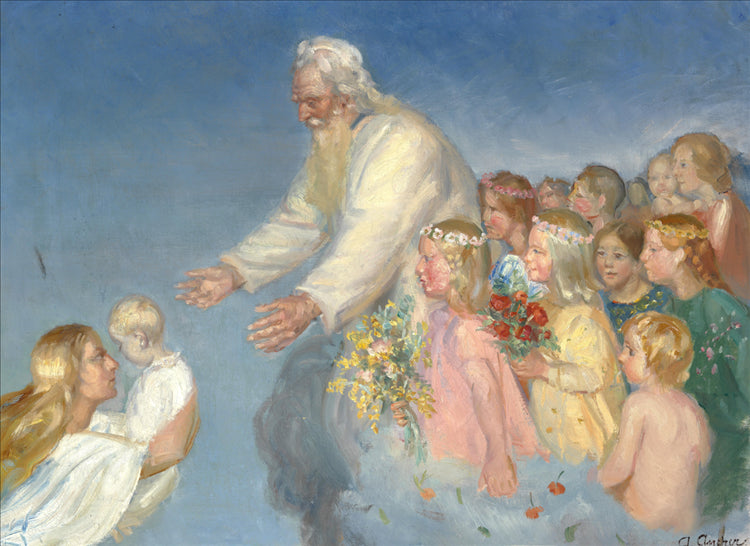Description
In the deepest sense, the painting "Our Lord receives the dead child" of Anna Ancher, created in 1917, faces us to a moving and poetic representation of death and spirituality, two themes that the Danish artist addresses with an unmatched sensitivity . Ancher, recognized for its ability to capture the life and light of the family environment, takes this same mastery to a more gloomy context, but equally full of meaning.
The work presents a child, laying inert, in the center of the composition, with a gentle lighting that highlights his figure. Light plays a fundamental role; Its direction and intensity give an almost divine atmosphere to the scene. The warm back of the background contrasts with the paleness of the child, creating a visual narrative of hope in pain, a sign of the eternal that predominates in the work. The choice of color, predominantly terrible tones and clear nuances, suggests a connection with nature and life itself, while, at the same time, it invites contemplation of the inevitable: death.
The characters that appear in this work are mostly figures that are shown faintly around the child, almost ethereal. These presences, which seem to be religious figures, are intertwined with the spirituality of the moment, suggesting an environment in which the duel is intertwined with faith. Through the representation of these figures, the painter evokes a sense of community and accompaniment in suffering, giving the scene of human warmth in her sadness. The faces of the figures seem to reflect a set of emotions that oscillate between sadness and reverence, which refers to the acceptance of the child's destiny.
Ancher, often associated with the movement of Danish impressionism, shows influence of their surroundings and those who surrounded it. The way it uses light and color can be seen in contemporary works such as Peder Severin Krøyer. However, in "Our Lord receives the dead child," Anchar seems to go beyond the mere representation of reality, creating a space where painting becomes a vehicle for reflection on universal issues such as life, death and death and The divine.
The work, although marked by pain, invites a serene contemplation, characteristic of religious art. Ancher, by showing Christ in an act of receiving the child, places the religious figure in a position of comfort, providing a compassion and tenderness look that defies the seriousness of the subject. It is a reminder that, despite human suffering, there is beauty in transcendence and hope that faith can offer.
In conclusion, "Our Lord receives the dead child" is much more than a simple painting; It is a meditation on life and death, which invites the viewer to enter an intimate reflection space. Ancher, through its masterful use of light and color, and its sensitivity towards the human condition, manages to create a work that resonates deeply in the spiritual and emotional field, positioning itself as an outstanding example in the Danish artistic legacy of the twentieth century. Thus, this painting is erected not only as a testimony of Anna Ancher's talent, but also as a lighthouse of contemplation on the most intimate moments of human existence.
KUADROS ©, a famous paint on your wall.
Hand-made oil painting reproductions, with the quality of professional artists and the distinctive seal of KUADROS ©.
Art reproduction service with satisfaction guarantee. If you are not completely satisfied with the replica of your painting, we refund your money 100%.

